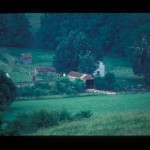
Photograph: Jerrye & Roy Klotz, MD
Recently I prepared a report at the request of the Greater Newport Rural Historic District Committee – whose National Register-listed district is one of several identified rural historic districts transected by the route of the proposed Mountain Valley Pipeline (MVP) across the Appalachians. My charge was to see whether the impacted districts met the criteria for a traditional cultural places” (or properties) – that is “TCPs” – per National Register Bulletin 38.
For those not directly affected by the proposed pipeline, some of the most interesting things that I learned from this effort were:
- The National Register nomination documentation for the historic districts was not very helpful in figuring out whether the districts were TCPs;
- The nominations were also of little use in ascertaining whether the districts were “rural historic landscapes” per National Register Bulletin 30;
- In fact, the documentation were unenlightening even about why the districts were viewed as districts; the documentation was overwhelmingly about the individual buildings, structures and sites within the districts, not about the districts as landscapes, or as the “concentrations” and “linkages” to which the Register’s definition of “district” refers.
Luckily, some very interesting and helpful studies had been done quite outside the context of historic preservation, about the “cultural attachment” that people in the area feel for their landscapes. Applying the results of these studies to the districts, it became clear that they – or perhaps more likely a landscape embracing all or some of them – was indeed eligible for the National Register as a TCP.
Why does this matter? After all most of the districts in question have either been listed on the National Register or authoritatively identified as eligible for it, hence are already entitled to consideration under Section 106 of the National Historic Preservation Act. I think it matters in at least two ways:
First, when one looks at a “district” nomination and finds a list of specific buildings, structures and sites, with little or no treatment of the spaces around them, it’s pretty easy to design a new project – like a power line or pipeline – right through the district and think you’re having no adverse effect on it, because your project doesn’t knock down or dig up a “contributing” building, structure or site. You may give some consideration to things like visual effects, but only on those “contributing resources.” The whole idea of the “district” as an entity gets lost.
Second, when a district is characterized only with reference to its constituent buildings, structures and sites – with their significance defined, of course, by historians, architectural historians, and archaeologists – one has no basis for appreciating what makes the district important to the people who live there, work there, or otherwise experience the place. The significance of the district to the people who value it is effectively submerged. When a question arises about a planned project’s potential effects on the district, the concerns of those people can easily be denigrated, as long as one can assure the world that one is not going to muck with the architectural qualities of a building/structure, or the archaeological values of a site.
So – the lesson I take away from this experience, and that I suggest to others, is: if you’re interested in preserving a place that’s important to you, and are encouraged to nominate it to the National Register or offer some representation about its eligibility, think carefully about what you call the place. If you call it a “rural historic district,” you may wind up with something that doesn’t help you much in terms of ensuring that the values you ascribe to the place are given due attention. If you call it a rural historic (or cultural) landscape or TCP you’re probably better off, but even then, pay careful attention to how whoever compiles the documentation describes the place. “Preservation professionals” may automatically slip into architectural and archaeological modes of thought when assigned to describe the historic and cultural qualities of a place. If you use such professionals, somebody needs to be looking over their shoulders to remind them to attend to the spaces around the buildings, structures, and sites, and particularly to listen to the people.
And if you’re a preservation professional (or non-professional) responsible for writing up a place with reference to its National Register eligibility, get familiar with the “cultural attachment” literature – which has mostly been produced with little or no (or ill-advised) reference to historic preservation, but is very, very relevant. My full paper including key sources to the literature can be found here.
Thomas F. (Tom) King is the author, co-author, or editor of ten books on aspects of cultural heritage, and the co-author of National Register Bulletin 38 on the identification and documentation of traditional cultural places. He is a consultant based in Silver Spring, Maryland, and can be contacted at tomking106@gmail.com.
This post was first published on the author’s blog CRM and is used with his permission.


